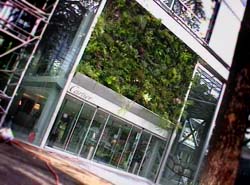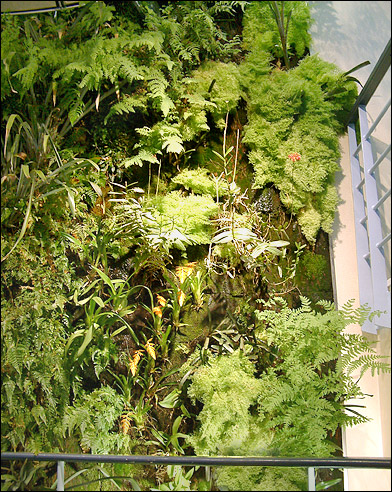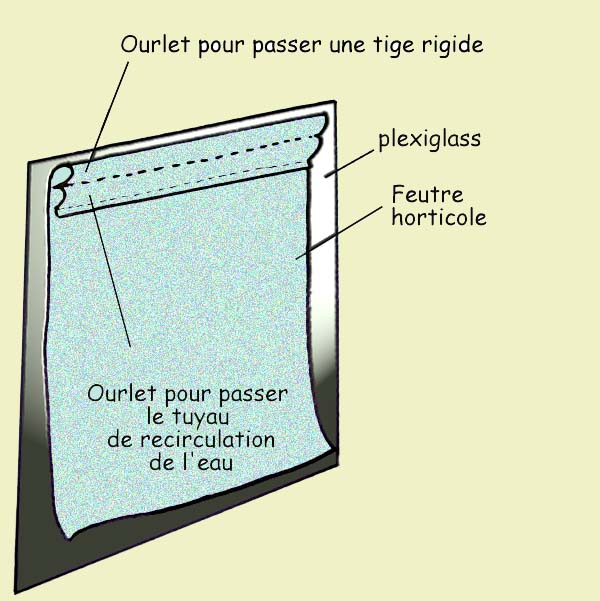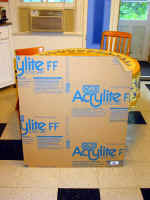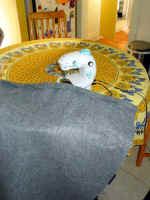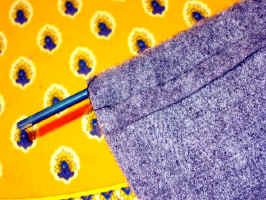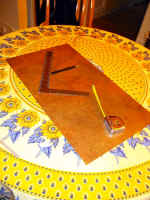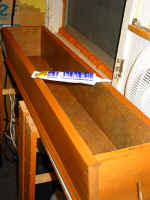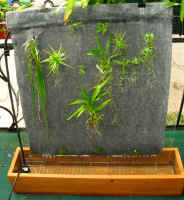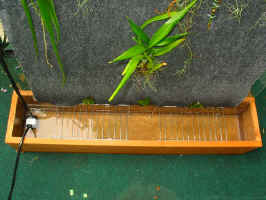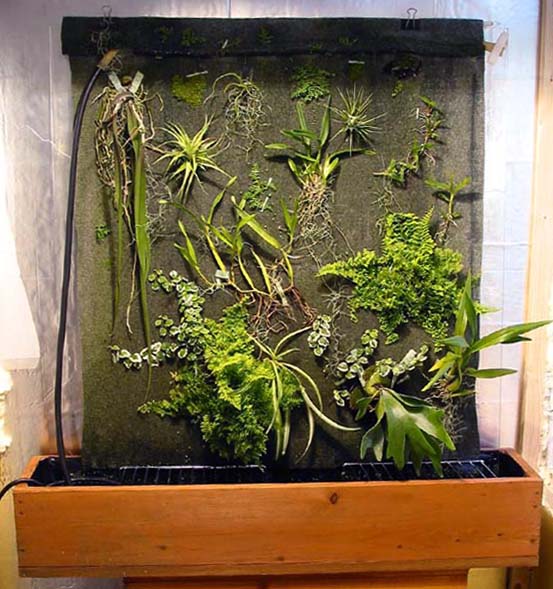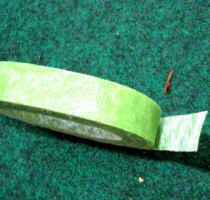Construction de mon mur à épiphytes
par Laurence, le 16 janvier 2004
| It is with the turning of one stores Géo which I met Patrick Blanc for the first time, at least one of its creations. Patrick Blanc it is this botanist of the CNRS which, by observing tropical plants push in their natural environment, with have the idea to recreate with the vertical the various stages of a wet drill tropical. The idea however simple is nevertheless brilliant: Plants are placed on an inert vertical support on which they are enracinent. They are nourished with drop by drop thanks to a nutritive solution which percole from top to bottom in the vertical support. The whole without ground, as on and the rock tree trunks of the wet forests. The result is an extraordinary vertical chlorophyl wall. Its walls equip from now on the grisaille with Paris. They give again with the plants right of city. Improbable oases of greenery, they are all at the same time lung and ornament in the heart of the city. |
One of the urban walls of Patrick Blanc |
|
One of the vegetable walls of Vivaria |
By their natural aspect, these urban vegetable walls immediately allured me and enormously inspired. Then a little later I lost myself hard the site of Vivaria. And still I saw superb vegetable walls there or the plants push directly on a support placed at the vertical: the modern version of the hanging gardens of Babylon ? Well on, I immediately wanted to reproduce at home this extraordinary ecosystem. Finally good, all things considered because my room of culture makes only 1m20 length on 1 m broad, nothing to see with the entry of Pershing Hall (this Parisian Hotel sublimely equipped with plants by Patrick Blanc). My idea was thus to build a vegetable wall or plants épiphytes and orchises would cohabit in good harmony. This system was to have the most natural possible appearance and a simple operating mode, with a need for maintains minimal... ha yes, last thing, budget also tightened to respect... |
I dreamed some, I did it this summer, and veiled later result 1 year:
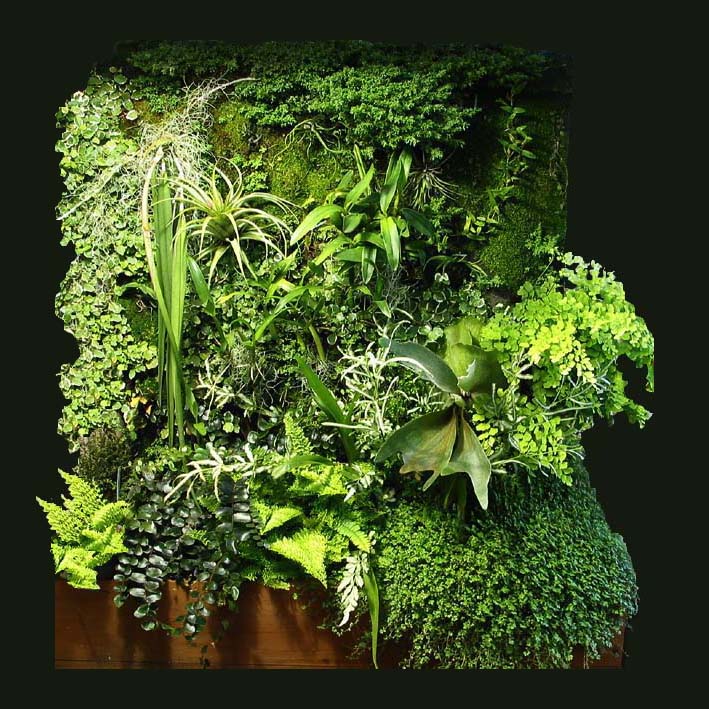
Dimensioned concept, it is rather simple: a plexiglass plate 0.9 m in height and 0.8 m broad covered with horticultural felt. The whole is deposited in one limps with flower seals and an aquarium pump recirculates water in top of the mini-wall. The orchises and other plants épiphytes are hung directly to the felt. Veiled, it is all!
Then one even starts with the wall part in it: you need a plate of plexiglass crossed to the good size (mine was sold just as it is in store of do-it-yourself, but you can make recut on the spot with the need), of the horticultural felt (or the aquanape, available in the stores of hydroponic material), a rigid rod same length as the width of the wall (me I took a tutor), wire and and grips with file (office supplies)...
It is necessary to start by cutting the horticultural felt to the good size. Personally, to prevent that water does not escape on the with dimensions one, I have it less broad cut 10 cm and less length which my plexiglass plate (either 70 cm broad by 80 cm length thus). Then I folded back the felt on 7 cm in top to allow itself to sew 2 slides, as indicated on the graph:
|
Note on the choice of the pump It is not necessary that the pressure in the top of the pipe is too high, if not the pump will force, it will surge what risks to damage it in the long run. The pressure in the top of the pipe is a function: bore, height of the wall, number and flow of the goutteurs and power of the pump... To avoid the problems it is thus necessary: to take a pump which has a flow of exit compatible with what one seeks. Cavity the flow of exit depends on the power of the pump and height of the wall (see here them specifications of my pumpwho give the flows to various heights). Thus best is to choose a variable-displacement pump - me for a 90 height cm wall I have a "little giant Pes-120-pw" (8 W, height max of 1m20, flow max of 200 l/h to 0.9 m as the pump is with max, flow variable) - With the minimal flow it delivers less than 50 l/h what is appropriate very well for my wall. If the pump has a too significant flow it is always possible to set up a by-pass, i.e. a circuit of derivation. One then places a connector in T on the outlet side of the pump to divert part of the flow of exit in the vat. One uses a small tap of aquariophilie to regulate the flow in the circuit of derivation).
|
Finally, connect the pump on a minuteur. for my part water is recirculated permanently on the wall during the day but not the night. During the day, the horticultural felt is just wet with the touch and ever saturated what allows a good health of the roots. Constant evaporation during the day makes it possible to maintain a hygroscopy raised for the plants which live on the wall.
In winter, my wall is placed on the wall of the bottom of my room of culture, under my horticultural lamp. I placed there of foam, the ferns, broméliacées and well on orchises whose majority are miniatures: Encyclia abbreviata, Haraella odorata, Dendrobium cuthbertsonii, Encyclia polybulbon, Howeara washed burst ' pumani ', Dichaea, etc... They enracinées all very well in the wall and thrive with their ease as one can note it by looking at the evolution of the wall in 6 months:
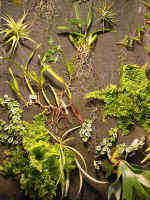
Août 2003 |
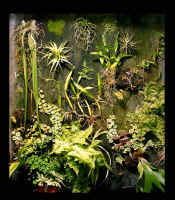
Octobre 2003 |
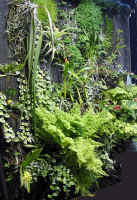
Décembre 2003 |
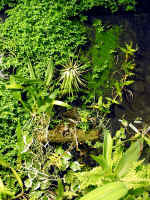
Détail, Décembre 2003 |
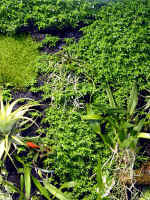
Détail, Décembre 2003 |
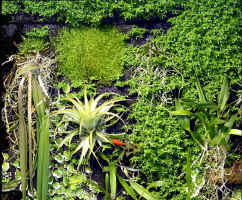
Détail, Décembre 2003 |
Dimensioned maintains, I brumise not daily the plants because the pump is given the responsability to water them. I am satisfied to add a water watering-can in the vat from time to time to compensate for evaporation. I use water of the fairly calcareous tap of which I adjust the pH between 5 and 6 with citric acid (lemon juice). Dimensioned fertilization, I go there very gently. Indeed considering the rate of evaporation on the wall is raised enough, fertilizer salts with tendency to concentrate in the vat, which the orchises do not appreciate forcing. The problem is less when the wall "is abundantly planted" because the plants absorb salts then quickly. But for those which do not have a conductimeter or whose wall is right in starting, I advise not to put manure directly in the vat and only to fertilize one time per week by abundantly vaporizing the plants with a diluted solution of manure. I also advise, for more safety, to change the water of the vat completely once by mois.miniatures: Encyclia abbreviata, Haraella odorata, Dendrobium cuthbertsonii, Encyclia polybulbon, Howeara washed burst ' pumani ', Dichaea, etc... They enracinées all very well in the wall and thrive with their ease as one can note it by looking at the evolution of the wall in 6 months:
Pour les coûts, ça donne à peu près cela: At the costs, that gives about that:
| Feutre horticole | 5 euros |
| Plaque de plexiglas | 15 euros |
| jardinière en bois | 10 euros |
| toile a bassin | 10 euros |
| pompe de recirculation | 20 euros |
| tuyau et goutteurs | 10 euros |
| total | 70 euros |
Thus veiled the history of my wall. How you see, nothing complicated but hours of pleasures accessible to the tightest budgets! Have fun; -)
For more photographs of my wall and to follow its evolution, return on My Site
